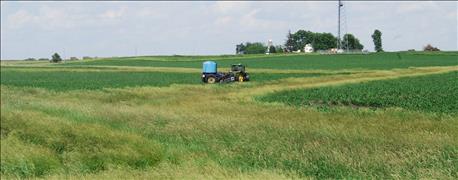
To be eligible to receive many USDA benefits, including loans, disaster assistance, federal crop insurance premium subsidies and conservation assistance, you must comply with requirements for highly erodible lands and wetlands.
"The purpose of the conservation compliance provisions set forth in the 2014 federal farm bill is to reduce soil loss on erosion-prone lands and to protect wetlands," explains John Whitaker, state executive director of USDA's Farm Service Agency in Iowa. "You need to make sure you are compliant. If you are not sure or if you have questions, contact your local FSA office. And do it now."
Deadline for conservation certification filing is June 1

DEADLINE: Farmers need to file a Highly Erodible Land Conservation and Wetland Conservation Certification form (AD-1026) with their local USDA/FSA office by June 1. This is to become eligible or remain eligible for crop insurance premium support.
Farmers seeking federal crop insurance premium subsidies for the 2016 reinsurance year must comply by June 1 by filing form AD-1026 at their local USDA Service Center office. The 2014 Farm Bill relinked crop insurance premium subsidies with conservation compliance. Justin Fritscher of USDA's Natural Resources Conservation Service explains the five steps you need to take to meet conservation compliance.
Step 1: See if conservation compliance applies to you
Conservation compliance applies to any person seeking benefits from certain USDA programs, including Farm Service Agency loans and disaster assistance, Natural Resources Conservation Service and FSA conservation programs, and Risk Management Agency (RMA) federal crop insurance premium subsidies. If you're seeking federal crop insurance premium subsidies for the 2016 reinsurance year, which runs from July 1, 2015 to June 30, 2016, you must be in compliance by June 1.
If you grow commodity crops and you have wetlands or highly erodible land, you may need additional assistance from FSA and NRCS to meet conservation compliance provisions. Commodity crops include any crop planted and produced by annual tilling of the soil, including one-trip planters or sugarcane.
Step 2: Check with FSA to see if you are in compliance
You must file form AD-1026 to initiate the compliance process. If you are uncertain whether you have previously filed the form, contact your local FSA office to see if you have the form on file and are in compliance with the provisions.
Step 3: Complete the USDA compliance Form AD-1026
Form AD-1026 is a compliance certificate used to:
•Inform you of highly erodible land and wetlands requirements;
•Certify compliance with those requirements;
•Identify you and anyone else who needs to complete the form; and
•Provide authorization for USDA representatives to service your determination request and check compliance.
~~~PAGE_BREAK_HERE~~~
Any person seeking a USDA program benefit must complete, sign and file form AD-1026 with FSA. Additionally, any affiliated person who has a separate farming interest must also complete, sign and file form AD-1026.
When you file form AD-1026, you are certifying that you will not:
•Plant or produce an agricultural commodity on highly erodible land without following an NRCS approved conservation plan or system;
•Plant or produce an agricultural commodity on a converted wetland; or
•Convert a wetland to make the production of an agricultural commodity possible.
Once the form is accurately completed and filed, it remains effective, and a person does not have to refile or update the form again, unless there are changes to the operation or new activities that occur that affect the person's certification. The form is not specific to a particular crop. It covers all land that a producer farms. If you have already filed form AD-1026 and are still in compliance, you have already met your filing requirement, and no further action is needed.
Step 4: Get in compliance, if you still need to do so
If your land does need a highly erodible land or wetlands determination, FSA will forward your form AD-1026 to NRCS, the agency responsible for making determinations. Determining whether you have highly erodible land is a simple process based on soil types. Determining whether you have wetlands on your property is a bit more complicated. In many instances, a field visit is needed to look at the soils, plants and hydrology of the site in question.
If needed, NRCS will work with you to develop a conservation plan for protecting highly erodible fields. This plan describes the conservation practices that may be needed to control soil erosion on highly erodible fields.
If you have wetlands on your land, you have a number of options, including leaving the wet areas unaltered, enrolling the land in a voluntary conservation program if eligible, and mitigating for wetland losses. See a full list of options at nrcs.usda.gov/compliance.
Step 5: Ensure that your farm stays in compliance
You remain in compliance by following the provisions of form AD-1026, any conservation plan you have, and any allowable wetland management options. Want to learn more? Check out USDA's conservation compliance webpage nrcs.usda.gov/compliance.
About the Author(s)
You May Also Like




